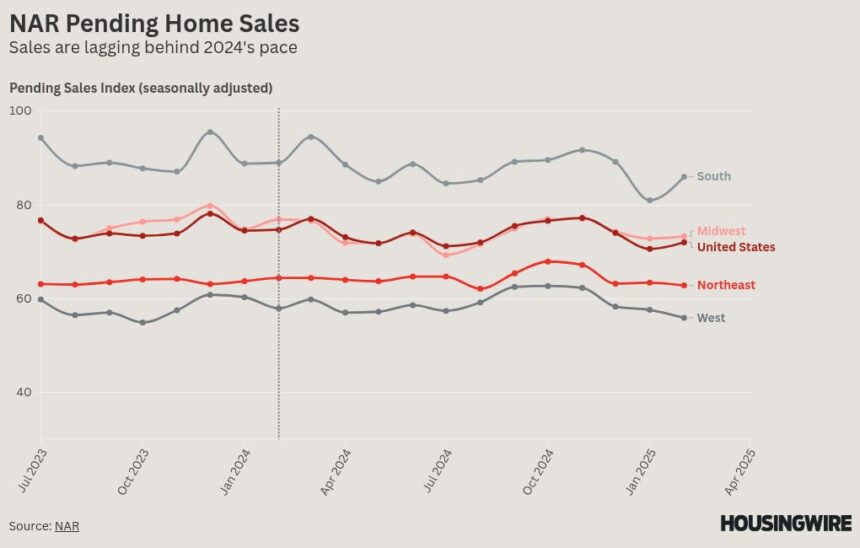Pending home sales serve as a preview of the housing market to come. And if February’s numbers are any indication, the real estate industry is in for a disappointing spring.
According to the Pending Home Sales Index released Thursday by the National Association of Realtors (NAR), pending home sales fell 3.6% compared to a year ago, although they were up 2% compared to January.
The month-over-month gain is encouraging, but the annualized decrease suggests that 2025 could be even worse than 2024, when sales hovered near 30-year lows. While the lag in sales is caused by the usual culprits, another concern has yet to be baked in — uncertainty related to President Donald Trump’s economic policies.
“Heading into spring, a modest seasonal increase in home-buying activity is expected,” First American senior economist Sam Williamson said in a statement. “Challenges like affordability constraints and the ongoing rate lock-in effect continue to weigh heavily compared to the dynamics of pre-pandemic spring markets.”
Pending home sales are a leading indicator for existing-home sales, and it takes a month or two for pending sales to show up in the latter dataset. But NAR’s report affirms the conclusion drawn from data by other leading indicators.
According to the Mortgage Bankers Association (MBA), loan applications for new-home purchases fell 6.9% year over year in February. Like pending sales, they inched up from January but only by 0.3%. The February new construction report from the U.S. Census Bureau showed a 6.8% annual decline in building permits and a 2.9% decline in housing starts.
The good news for homebuyers and real estate professionals is that inventory has risen rapidly all over the country, with NAR’s report showing a hefty 27.5% rise compared to last year. That tracks with Altos data, which shows huge year-over-year inventory gains in every state in the country, resulting in price declines in five states.
The outlook for the rest of the spring is murky due to the ongoing and escalating trade war. Trump has implemented a 25% tariff on all steel and aluminum products, and on April 2, a number of new tariffs are set to kick in, including potential levies on every country in the world and additional tariffs on Mexico and Canada. Lumber is also under threat of tariffs.
These tariffs are a blow to homebuilders. Should Trump allow them to take effect, it will damage the market for new homes. But they could also hinder demand if they cause inflation to rise — a conclusion reached by many economists.
“The outlook for slow market activity is not necessarily a foregone conclusion,” Bright MLS chief economist Lisa Sturtevant said in a statement. “Mortgage rates have fallen and could come down quickly if the economy slows.
“For some prospective buyers, the combination of lower rates and more inventory could be more important than economic uncertainty. It will take some time to see how the push and pull in the market will play out this spring.”







